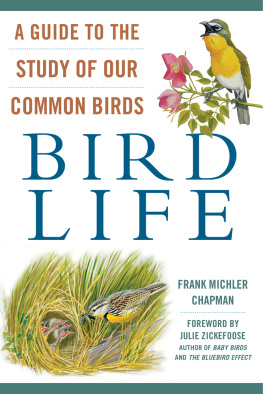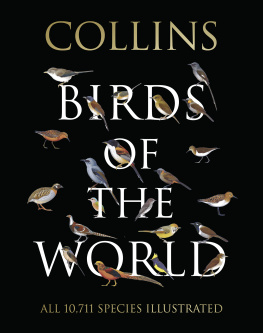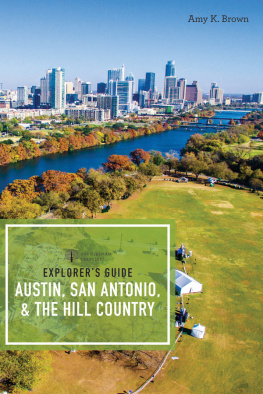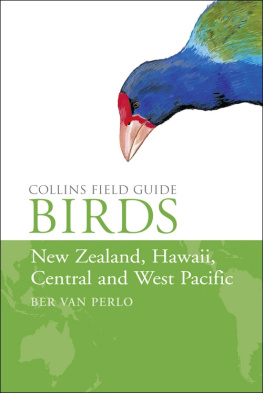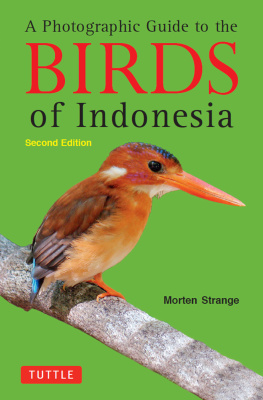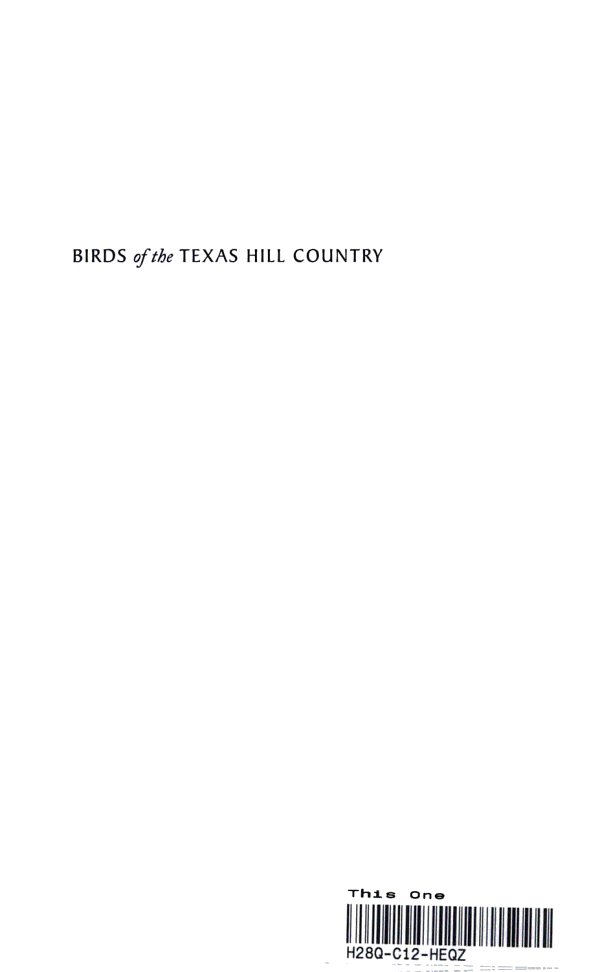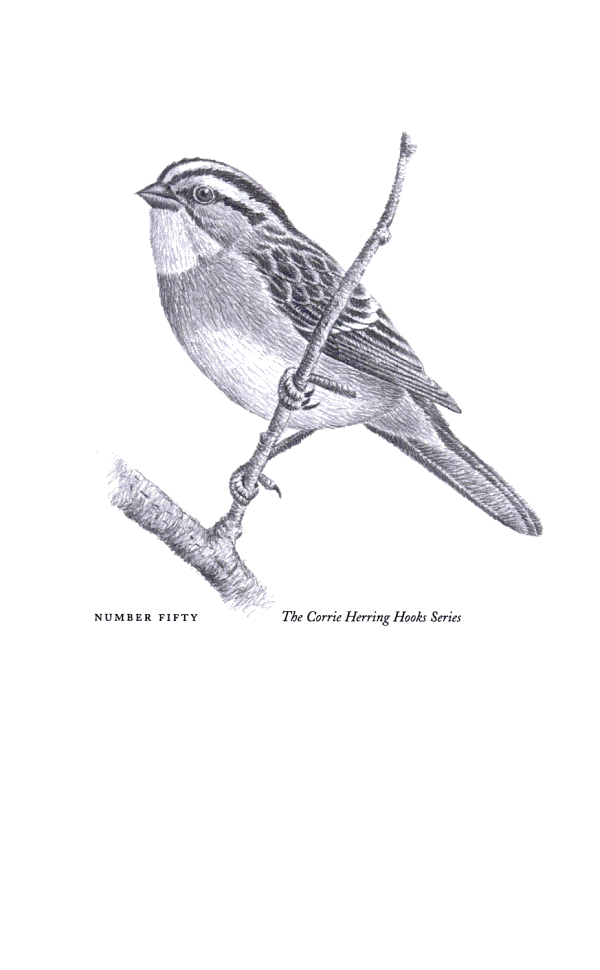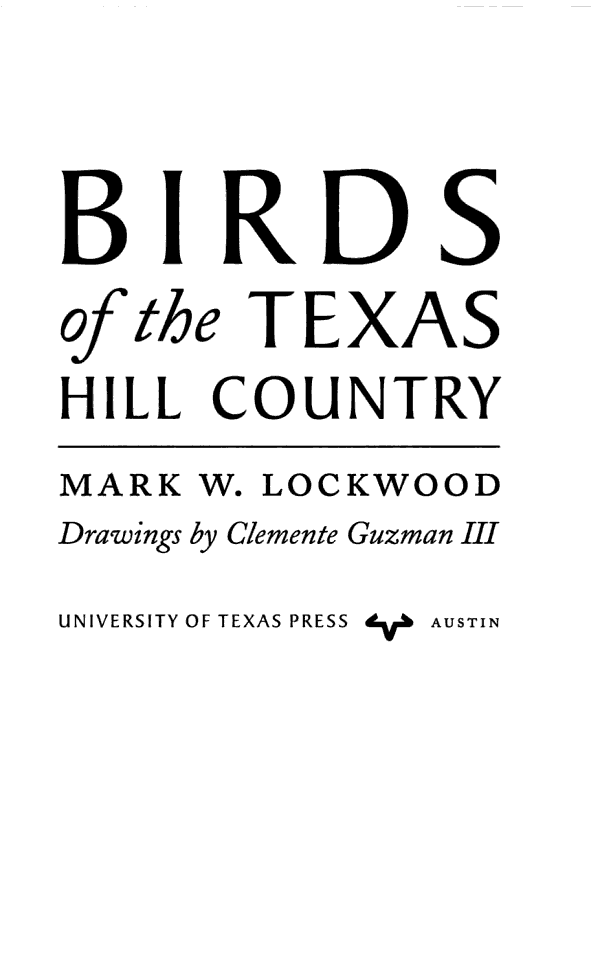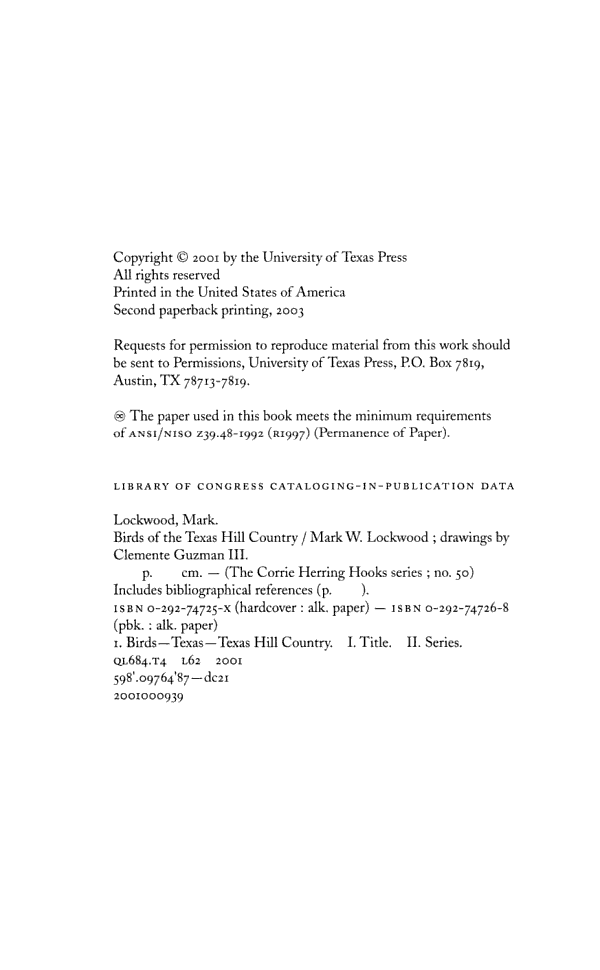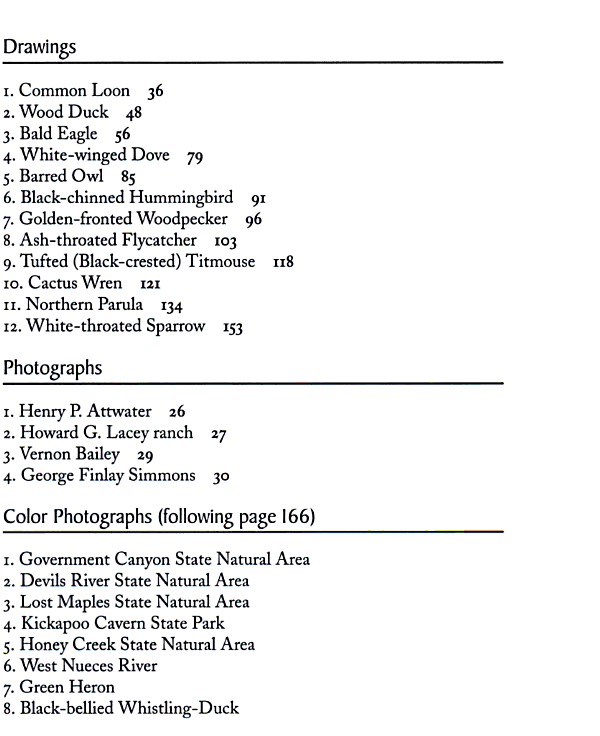For CindyI can never praise or thank her enough.
9. Montezuma Quail
10. Greater Roadrunner
11. Eastern Screech-Owl
12. Common Poorwill
13. Black-chinned Hummingbird
14. Green Kingfisher
15. Vermilion Flycatcher
16. Scissor-tailed Flycatcher
17. Bell's Vireo
18. Black-capped Vireo
19. Western Scrub-Jay
20. Cave Swallow
21. Verdin
22. Cactus Wren
23. Bewick's Wren
24. Golden-cheeked Warblermale
25. Golden-cheeked Warblerfemale
26. Summer Tanager
27. Canyon Towhee
28. Harris's Sparrow
29. Pyrrhuloxia
30. Varied Bunting
31. Painted Bunting
32. Lesser Goldfinch
Maps
1. Subregions of the Edwards Plateau 2
2. Counties within the Edwards Plateau Physiographic Region
3. Average Annual Precipitation on the Edwards Plateau 5
4. Birding Locations on the Edwards Plateau 10
Tables
1. Partners in Flight: Priority Bird Species for the Edwards Plateau 9
2. Seasonal Distribution of Edwards Plateau Birds 175
FOREWORD
Since at least the days of the Republic of Texas (1836-1845), when the site of Austin was chosen as the new capital, Texans have revered their Hill Country and Central Mineral Region. German settlement in the mid-nineteenth century gave us a cultural legacy remaining today in New Braunfels, Fredericksburg, Boerne, Mason, and many other quaint communities nestled among the wooded hills and spring-fed valleys. The drier western plateau, then part of dreaded Comancheria, was entered only by brave souls indeed.
Modern Texans continue to regard the Edwards Plateau and its Hill Country as the historical and cultural heart of our state. Appropriately, it has in recent decades assumed a new role in step with our nation's rising interest in all things natural. Its legendary streamsGuadalupe, Comal, San Saba, Frio, Llano, Pedernales, Blanco, San Marcos, Devils, Medina, Sabinal, Nueces, whose very names speak to historyare treasured today by growing numbers of residents and ecotourists. Hummingbird feeders that attract such wonderfully improbable sights as Green Violet-ears number in the thousands along these stream valleys. Its life forms and their conservation now often take center stage in Texas biodiversity concerns.
The plateau is of international faunal fame. Blind catfishes and ghostly white salamanders live in an astonishing aquifer, often deep below Earth's surface. Without question though, the star attraction birdsis the point of this book. For example, among the three highest profile endangered birds in Texas (Black-capped Vireo, Goldencheeked Warbler, and Whooping Crane), the first two are specialists of the Edwards Plateau.
We naturalists who live on the Edwards Plateau or who visit it to enjoy the pleasures of its birdlife have, in this book, our first modern description of that fauna. The University of Texas Press has come to our aid for the third time in support of this need. They published Simmons's 1925 Birds of the Austin Region and Oberholser's 1974 The Bird Life of Texas. Both of these works now stand dog-eared on my shelves, and an updated and comprehensive Edwards Plateau focus has been needed for some time.
We are fortunate indeed that Mark Lockwood stepped forward to write this long-awaited book. Following teenage years of birding and earning a statewide reputation, young Lockwood finished bachelor's and master's degrees at Sul Ross State University. In 1991 he began a career with Texas Parks and Wildlife in the southwestern Edwards Plateau at Kickapoo Cavern State Park. It was here that his interest in the region matured, and he became a serious student of the plateau bird fauna. Today he continues his state career headquartered in Austin and has devoted much of his recent professional service to surveying the plateau distribution of Black-capped Vireo and Golden-cheeked Warbler. He has published many papers in both science and birding journals and is secretary of the Texas Bird Records Committee of the Texas Ornithological Society. I can imagine no finer background for the author of this book.
Count yourself fortunate that this book has arrived and that Lockwood is your guide. I recommend that you settle back for an enjoyable and highly informative read and then follow Lockwood's directions to a personal field study of Edwards Plateau bird life. And by all means, keep this book close at hand. This now is the modern baseline to which your discoveries will be compared.
TERRY MAXWELL
ACKNOWLEDGMENTS
This book is a reflection of the efforts of the many ornithologists and birders who have reported their findings on the Edwards Plateau. Over the past 40 years, much of that information was provided to the editors of what is now known as North American Birds. Without this free flow of information and the means with which to archive it, status and distribution works on a landscape scale would be a far more difficult undertaking. I would like to thank everyone who has taken the time to submit their sightings to their local birding group, the Texas Ornithological Society, or to North American Birds. Birders who contribute their sightings play an important role in documenting the ornithological history of Texas.
There is a group of people who have spent a considerable amount of time on the Edwards Plateau and who have shared detailed information about sightings from the region with me. I owe a debt of gratitude to John Arvin, Doug Booher, Kelly Bryan, Brush Freeman, Tony Gallucci, John Gee, Nick Jackson, John Karges, Greg Lasley, Terry Maxwell, Art and Hanna Richard, Willie Sekula, Chuck Sexton, Paul Sunby, and Sue Wiedenfeld. Sue Wiedenfeld also shared with me a database of Ernest and Kay Muller's observations. Don Connell provided one of the most significant sources of information about birds on the eastern plateau. He graciously allowed me to examine the banding records from the Driftwood Banding Station. This banding station has been in existence for almost 20 years, and Don's commitment to that effort is to be commended.
Reviewing the manuscript of this book was a daunting task. I would like to thank Brush Freeman, Greg Lasley, Terry Maxwell, Jim Peterson, David Riskind, Chuck Sexton, and Cliff Shackelford for their thoughtful comments. Their careful review greatly improved the final product. Dr. Stan Casto was instrumental in the development of the early history of ornithological investigation on the plateau section of the introduction. Stan provided me with details on many of these men as well as the photos that appear in that section of the book.
Kelly Bryan, Tim Cooper, and Greg Lasley graciously allowed me to use some of their photographs to illustrate this book. They are all talented photographers, and I am pleased to be able to include some of their work here. The pencil drawings that can be found scattered throughout the book are the work of Clemente Guzman III. Clemente is a graphics artist at Texas Parks and Wildlife, and it has been my pleasure to work with him on several projects.




